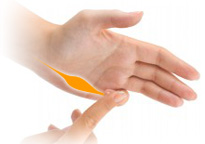What is Dupuytren’s Disease?
Dupuytren’s disease (also called Dupuytren’s contracture, Morbus Dupuytren, or palmar fibromatosis) is a slow developing, usually painless, connective tissue disorder affecting the hand. It causes a thickening and shortening of the tissue beneath the skin on the palm of the hand. Eventually this can result in one or more of the fingers being pulled toward the palm, making it difficult or impossible to extend the fingers. Its cause is not known, although heredity can play a role. It occurs more often in men than women.
Symptoms
In the early stages you may see or feel a small lump in the palm of the hand, usually near the fingers. As the disease advances, a fibrous cord develops, pulling one or more fingers toward your palm; it usually affects the ring finger and/or pinky finger.
Although this condition does not usually cause pain, it can affect your quality of life by making it difficult, if not impossible, to flatten your hand, thereby affecting your ability to do simple things like wash your hands or grip things properly.
Diagnosis and Treatment
Diagnosis begins with a thorough physical examination. This may include x-rays or other diagnostic tests. Depending on the severity of the condition and how long it has persisted, treatment options could include both surgical and non-surgical plans.
Although renowned for his surgical ability, Dr. Asif is a firm believer in using conservative, non-operative treatment plans before considering surgery. For Dupuytren’s disease, this could include splints, therapy, and range of motion exercises.



